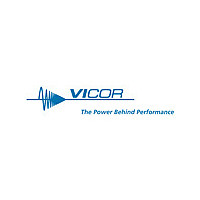VI-HAM
Harmonic Attenuator
Modules
Figure 1b.
Features
Figure 1a.
Above: Oscilloscope photos showing input
voltage and current without power factor
correction (A) and with power factor correction
as provided by the VI-HAM (B).
12
Unity Power Factor
Safety Agency Approvals:
UL, CSA, TÜV, BABT
Meets IEC 6100-3-2 for Line
Current Harmonic Content
Reduces Peak and RMS Line
Currents
Universal Input: 85-264Vac:
50/60 Hz
Up to 600W of Power
Power Density Up to100W/in
Adaptive Output Voltage Control
Short-Circuit Protection
Input Surge Current Limiting
Converter Enable
Power OK Output
Size: 4.6" x 2.4" x 0.5"
(116,8mm x 61,0mm x 12,7mm)
Efficiency: 90-94% Typical
CE Marked
3
1-800-735-6200
Unity Power Factor
Conventional capacitive-input front ends draw
energy from the AC line in short bursts of current
at the peaks of the line voltage waveform. These
current bursts are characterized by high peak currents
and high harmonic content. The effect of the
distorted line current can be appreciated by
measuring the rms line current drawn by a
conventional front end: the product of the
measured rms current and the rms line voltage —
the "apparent power" being delivered by the line
— will be significantly greater (typically 1.6X)
than the DC power delivered by the front end.
The "extra" rms current at the input is circulating
harmonic currents which deliver no power to the
load but which flow in the delivery system and
contribute to losses. Only the fundamental
component of the line current contributes to "real"
power flow. Power factor — the ratio of "real" to
"apparent" power — is a measure of the
effectiveness with which an AC load can extract
usable power from an AC source.
The VI-HAM (see Fig. 2) consists of a
full-wave rectifier, a proprietary high-frequency zero-
current switching (ZCS) boost regulator (patents
applied for), active inrush, short-circuit protection,
control and housekeeping circuitry. The incoming
AC line is rectified and fed to the ZCS boost
converter. The control circuitry varies the operating
frequency of the ZCS boost converter so as to
simultaneously maintain the output voltage of the
HAM at a DC voltage value above the peak of the
incoming line, while forcing the input current to
the ZCS converter to follow the waveshape of the
rectified line. By this means, the AC input current
follows the AC voltage waveform and a power
factor better than 0.99 is achieved. Operating
efficiency of the ZCS boost converter is optimized
at any incoming line voltage by a patented
adaptive output voltage control scheme.
Gate Out
NOTE: No input to output isolation.
Gate In
Line
AC
Waveform
Voltage
Recti-
fier
Figure 2 • VI-HAM Block Diagram
Converter
& House-
Circuitry
keeping
Control
Current
Sense
Boost
ZCS
Aux. Supply
The HAM also includes active circuitry which
controls inrush currents when power is applied and
active short circuit protection circuitry — features
not normally found in conventional power factor
correctors.
Housekeeping circuitry provides two signals of use
to the system designer (see Fig. 2): Module Enable
and Power OK. Referencing the timing diagram
(see Fig. 3), the Module Enable signal, which is
connected to the Gate In inputs of the Vicor DC-
DC converters powered by the HAM, will come
high and enable the DC-DC converters when the
HAM output voltage exceeds 240Vdc. The
DC-DC converter voltage outputs will be up
approximately 10 ms after Module Enable goes
high. Typically, 20 ms after Module Enable goes
high the HAM Power OK signal, which can be
used by the system designer to enable circuitry
powered by the DC-DC converter modules, goes
low. On loss of power or brownout, the Power OK
signal will go high when the HAM DC output
voltage drops below 230V, signaling an impending
loss of input power to the converter modules.
When the DC output dips below 195V, the Module
Enable signal will toggle low, disabling the
converter modules and unloading the HAM.
The HAM will provide at least 16 ms of
ride-through or holdup time, and at least 5 ms of
AC fail warning time with a 1000 µF output
capacitor.
High Frequency
Control
Output Voltage
Module Enable
Protection
Power OK
& Short
Circuit
Inrush
Out
DC
Note:
Non-Isolate
Output
+
–









